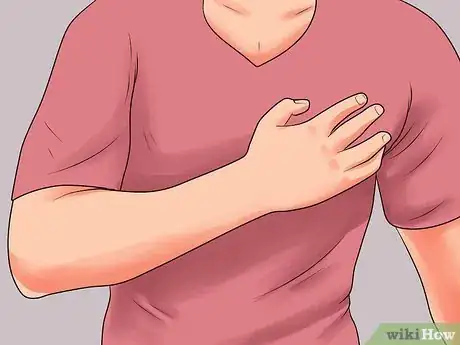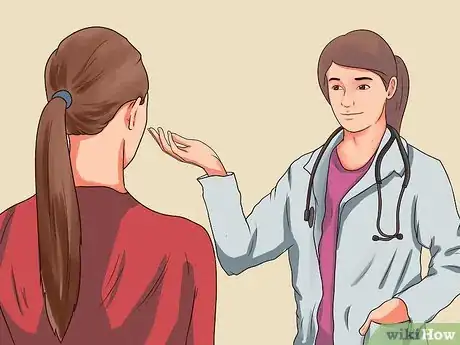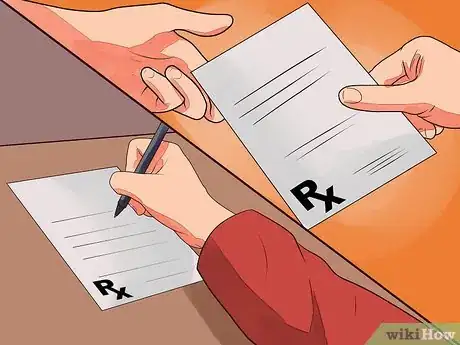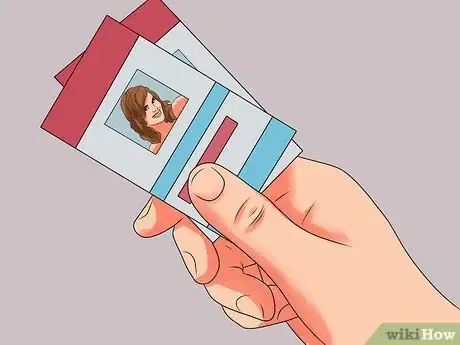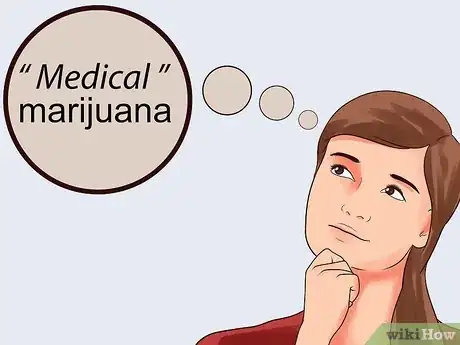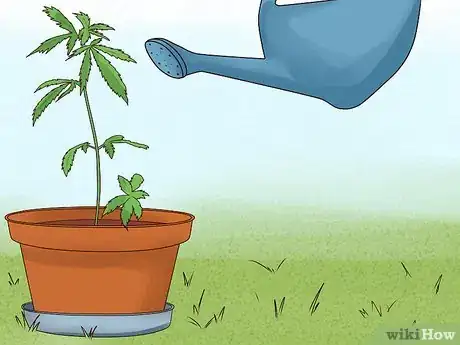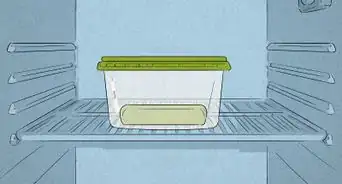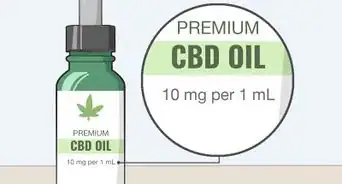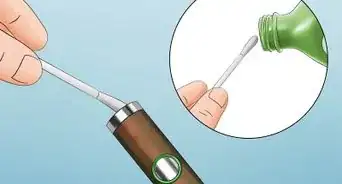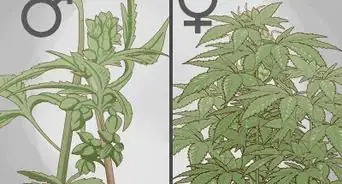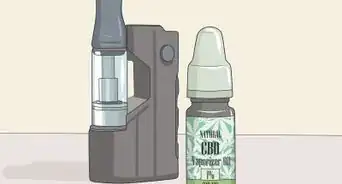This article was co-authored by Jamie Corroon, ND, MPH. Dr. Jamie Corroon, ND, MPH is the founder and Medical Director of the Center for Medical Cannabis Education. Dr. Corroon is a licensed Naturopathic Doctor and clinical researcher. In addition to clinical practice, Dr. Corroon advises dietary supplement and cannabis companies regarding science, regulation, and product development. He is well published in the peer-review literature, with recent publications that investigate the clinical and public health implications of the broadening acceptance of cannabis in society. He earned a Masters in Public Health (MPH) in Epidemiology from San Diego State University. He also earned a Doctor of Naturopathic Medicine degree from Bastyr University, subsequently completed two years of residency at the Bastyr Center for Natural Health, and is a former adjunct professor at Bastyr University California.
wikiHow marks an article as reader-approved once it receives enough positive feedback. This article has 13 testimonials from our readers, earning it our reader-approved status.
This article has been viewed 485,336 times.
Increasingly, medical marijuana programs are becoming more and more accepted in the United States. Available in almost half the country, state-issued ID cards are available for patients with qualifying conditions who negotiate the application process properly. Knowing what is and isn't allowed, along with expert tips on how to get a card, will make you a more educated patient. Read on for more information.
Steps
Qualifying for Medical Marijuana
-
1Make sure medical marijuana is available in your state. Many states are moving forward with medical marijuana programs, but it's not available everywhere. Programs are still controversial, and marijuana is still classified federally as a Class 1 Drug. If you're interested in using marijuana to treat your condition, find out the laws in your state regarding use by clicking here. States with medical marijuana programs in place include:
- West Coast: Arizona, Colorado, California, Montana, Nevada, New Mexico, Oregon, and Washington
- East Coast: Connecticut, Delaware, New Hampshire, Massachusetts, Vermont, New York, New Jersey, Rhode Island, Maine, Maryland and Florida.
- Midwest: Michigan, Minnesota, and Illinois
- Alaska, Hawaii, and the District of Columbia
-
2Find out what conditions are pre-approved. You won’t qualify for medical marijuana because you want to use it recreationally, even if recreational use is one of your goals. In most states, medical marijuana is only available to patients with pre-approved conditions, while other states, including California, make medical marijuana more widely available for a variety of conditions.[1] In general, universal pre-approved conditions include:
- Chronic and severe pain, including pain from arthritis, migraine headaches, and Crohn’s disease
- AIDS
- Chemo-related nausea
- Hepatitis C
- Multiple Sclerosis
- Asthma
- Epilepsy
- Alzheimer’s Disease
- Any terminal illness
Advertisement -
3Talk to your doctor about your interest in alternative medications. Without a severe illness, most general practitioners will not recommend the use of medical marijuana, unprompted. Talk to your doctor about whether or not using marijuana might be right for your conditions and concerns and discuss your specific conditions that you think might be aided by medical marijuana.
- Often, medical marijuana will be recommended as an alternative to more traditional forms of medication. If you've been on other medicines and they haven't helped, this can be a good in-road to talking about medical marijuana with your doctor.
- Likewise, if you're feeling frustrated with nausea, sleeplessness, or other side-effects as a result of any medications that you're taking, medical marijuana can be an appropriate supplement to other prescriptions that you might be taking.
- Your doctor will likely ask you about your current symptoms, past medical history, and history using prescription or recreational drugs.[2]
-
4Seek out a secondary opinion if your doctor is reluctant. Your general practitioner is the best doctor to talk to about any prescription, but many are hesitant to recommend the use of medical marijuana. Often called “420 doctors” or “pot docs,” entrepreneurial doctors in many states with medical programs are available for a consultation fee and few questions asked. If you’re interested in using medical marijuana to relieve things like writers’ cramp and insomnia, say, a 420 doctor is probably the place to go.
-
5Get a prescription or a recommendation. Make an appointment with your doctor or with a doctor who specializes in medical marijuana, and discuss your ailments and your desire to explore medical marijuana. You should walk out with a prescription in hand, which you can use to register as a user with the state and make your purchase from the dispensary.
- Prescriptions and recommendations are legally protected under patient confidentiality laws. This doctor's recommendation will not be available to potential employers, law enforcement, and other inquiries.[3]
Applying for a Medical ID Card
-
1Learn how the ID card can help protect you from arrest. Depending on what state you live in, registering as a medical marijuana user with the state may be mandatory or voluntary, but it’s important to understand the difference and the way in which registration can protect you legally. The purpose of the card is to identify you to vendors and law enforcement as a registered and legal user of medical marijuana.
- In California and Maine, patient ID cards are voluntary, meaning that you can take your prescription directly from your doctor to a dispensary, provided you've got a valid state ID. Without a Patient ID card, however, police have no indication that you’re a "legal" user, making arrests (if not convictions) somewhat more likely.
- Nevada, New Hampshire, Maine, Michigan, and Rhode Island will also allow you to purchase medicine if you’ve got a state-issued card from any state, meaning that you’ll also have the option of procuring medicine in multiple states, if you go through the registration process in your own state.
-
2Learn about some activists' concerns about the ID database. Many users are concerned that registering as a marijuana user with the state will open them up to prosecution by the DEA, or will affect future employment in other states. Most states have privacy safeguards in place, retaining nothing in the database but a randomized ID number and a photo of the registrant. The DEA has announced publicly that it has no interest in pursuing individual users of medical marijuana.[4]
- For the most part, passing drug tests will be more important to your ability to secure future employment. While the legality of medicinal marijuana is in a complicated gray area, registration should in no way affect your future employment.
-
3Bring your prescription and identification to the public health department. In most states, you'll register for your medical marijuana ID card at the office of the department of public health in your county, and you'll need to register and fill out the paperwork in person. You'll need to bring a state-issued form of identification, like a driver's license, as well as your doctor's recommendation.
- To apply, you'll need to be able to prove that you're a resident in the state and county in which you're applying. If you don't have a valid state-issued ID, you can still apply, provided you've got some form of identification that's up-to-date and legal in another state. You can use bills, leases, or other documents to prove your residency in the state.
-
4Complete and submit the application. Fill out the paperwork in person and submit it to the department of public health. In most states, there should be a waiting period and a fee associated with the application, usually somewhere in the neighborhood of $50. More specifically, you can find out the requirements for your state by visiting the website of the department of public health or visiting in person.
Buying Medicine
-
1Use the other “m” word. When you visit a dispensary, when you talk to your doctor, and anytime you’re talking about your purchases, it’s a good idea to get in the habit of referring to it as medicine, not “weed” or “pot” or other slang terms. This is the approved dispensary term.
- Medical marijuana activists have done lots of work to change the vocabulary and the connotations with marijuana. The more you work to refer to it as medicine, the more it will be accepted as medicine. Calling it "pot" reinforces the stigma that you're using recreational drugs, not legal medicine.
-
2Find an approved dispensary close to you. Most dispensaries are cooperative organizations registered with the state to provide high-quality plants and medicine to registered patients. After receiving a doctor's recommendation and a state-issued ID card, you can visit the dispensary closest to you to become a member and make your purchases. Often, dispensaries will also provide you with a membership card, making it easy to recognize you as a registered patient.
-
3Learn about what products to expect at the dispensary. There are many ways of consuming medical marijuana, and some may be more appropriate than others, depending on your needs and your conditions. Getting informed about the different products and techniques will help make the dispensary less intimidating.
- Combustible flowers, oils, and concentrates are consumed in the traditional way, by smoking. Many dispensaries will offer pre-rolled cigarettes and different strains of loose marijuana flowers at a variety of price-points.
- Non-combustible hardware like vaporizers are also available at many dispensaries, for patients interested in healthier smoking options. Non-combustible consumption means that the THC–the active ingredient in marijuana–is vaporized and inhaled, without the harmful carcinogens from the smoke.
- Edibles, tinctures, and drinks are extremely user-friendly. You can buy cookies, brownies, and drinkable THC-infused products to medicate your condition. If you're not a fan of smoking marijuana, this is the best option for most users.
- Topical sprays, creams, and analgesics are also available in some dispensaries. These localize THC that can be absorbed through the skin for topical pain-relief treatments.
-
4Decide whether or not growing might be right for you. Many dispensaries also sell plant-starts and seeds for use in home cultivation. Registering as a patient also allows you to grow a small amount of marijuana for your own consumption, so if you live in a rural area without easy access to a dispensary, this option may be better for you. Depending on what state you live in, the amount of plants you’re able to grow will vary, but it’s usually considerable.
-
5Know your rights. Medical marijuana users are in a somewhat strange position of being permitted to do something in the state that's illegal at the federal level, so it's especially important to know your rights and your responsibilities when it comes to using medicine.
- Your records as a registered user of medical marijuana fall under patient confidentiality and customer confidentiality laws in most states, and it's illegal for employees to consult the data found in your "file." There should be no connection between your driver's license and your SSN and your medical marijuana registration.[5]
- If you're pulled over, you do not need to present your medical marijuana ID card preemptively, unless you're being cited for a marijuana-related offense. You do not need to permit a search without probable cause.
- Patient-confidentiality laws guarantee that doctor's recommendations will be kept private from all law enforcement inquiries. The fact that you've been recommended to use a legal drug by a medical professional is no one's business but your own.
-
6Use your medicine safely and responsibly. Even if it's legal, strictly speaking, you still need to take a lot of responsibility to keep yourself safe. Use your medicine in private, never smoke in areas where smoking is prohibited, and
- Don't take medical marijuana across state lines, especially into states without medical marijuana programs in place. Any time you're transporting cannabis, keep your medical ID card handy and never ever smoke while you're driving. Keep medical marijuana in airtight containers and in the trunk. The smell of marijuana counts as probable cause for search.
- THC stays in your system for days after use, meaning that other traffic infractions can carry with it an added "operating while intoxicated" charge, even if you're no longer "high." Never drive after smoking marijuana. Treat your medical marijuana use the same as you might treat the consumption of alcohol or other prescription drugs. Do it in the safety of your own home.[6]
References
- ↑ http://medicalmarijuana.procon.org/view.resource.php?resourceID=000881.
- ↑ Jamie Corroon, ND, MPH. Medical Director of the Center for Medical Cannabis Education. Expert Interview. 10 March 2020.
- ↑ http://www.canorml.org/prop/sb420IDcards.htm
- ↑ http://www.canorml.org/prop/sb420IDcards.htm
- ↑ http://www.eastbayexpress.com/oakland/the-truth-about-medical-marijuana-card-privacy/Content?oid=3426638
- ↑ http://www.unitedpatientsgroup.com/blog/2012/03/28/common-courtesy-no-nonsense-medical-marijuana-advice/
About This Article
To get medical marijuana, start by making sure it's offered in the state where you live, then find out which medical conditions automatically qualify you to receive medical marijuana. If your health issue isn't on the list, make an appointment with your doctor so you can talk about your condition and, if it's deemed medically necessary, your doctor will write you a prescription. Then, take your prescription and state-issued photo ID to the public health department to register for your medical ID card. For tips on using your ID card to buy medical marijuana, read on!

